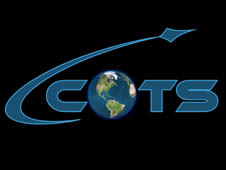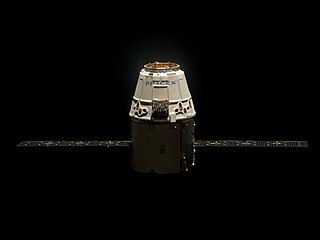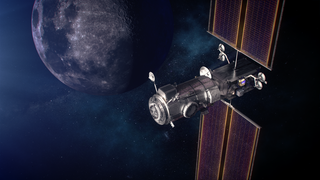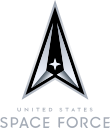
The Space Shuttle program was the fourth human spaceflight program carried out by the U.S. National Aeronautics and Space Administration (NASA), which accomplished routine transportation for Earth-to-orbit crew and cargo from 1981 to 2011. Its official name, Space Transportation System (STS), was taken from a 1969 plan for a system of reusable spacecraft of which it was the only item funded for development. It flew 135 missions and carried 355 astronauts from 16 countries, many on multiple trips.

Dream Chaser is an American reusable lifting-body spaceplane being developed by Sierra Nevada Corporation (SNC) Space Systems. Originally intended as a crewed vehicle, the Dream Chaser Space System is set to be produced after the cargo variant, Dream Chaser Cargo System, is operational. The crewed variant is planned to carry up to seven people and cargo to and from low Earth orbit.

Commercial Orbital Transportation Services (COTS) was a NASA program to coordinate the development of vehicles for the delivery of crew and cargo to the International Space Station by private companies. The program was announced on January 18, 2006 and successfully flew all cargo demonstration flights by September 2013, when the program ended.
American private space transportation company SpaceX has developed and produced several spacecraft named Dragon. The first family member, now referred to as Dragon 1, flew 23 cargo missions to the ISS between 2010 and 2020 before being retired. With this first version not designed for carrying astronauts, it was funded by NASA with $396 million awarded through the Commercial Orbital Transportation Services (COTS) program, with SpaceX being announced as a winner of the first round of funding on August 18, 2006.

Cygnus is an expendable American cargo spacecraft developed by Orbital Sciences Corporation and now manufactured and launched by Northrop Grumman Space Systems as part of NASA's Commercial Resupply Services (CRS) program. It is usually launched by Northrop Grumman's Antares rocket, although three flights were on ULA's Atlas V and three are planned to launch on SpaceX' Falcon 9. It is designed to transport supplies to the International Space Station (ISS) following the retirement of the American Space Shuttle. Since August 2000, ISS resupply missions have been regularly flown by the Russian Progress spacecraft, as well as by the European Automated Transfer Vehicle, and the Japanese H-II Transfer Vehicle. With the Cygnus spacecraft and the SpaceX Dragon, NASA seeks to increase its partnerships with domestic commercial aviation and aeronautics industry.
Space logistics is "the theory and practice of driving space system design for operability and supportability, and of managing the flow of materiel, services, and information needed throughout a space system lifecycle." It includes terrestrial logistics in support of space travel, including any additional "design and development, acquisition, storage, movement, distribution, maintenance, evacuation, and disposition of space materiel", movement of people in space, and contracting and supplying any required support services for maintaining space travel. The space logistics research and practice primarily focus on the modeling and management of the astro-logistics supply chain from Earth and on to destinations throughout the solar system as well as the system architecture strategies to minimize both logistics requirements and operational costs of human and robotic operations in space.

Commercial Resupply Services (CRS) are a series of flights awarded by NASA for the delivery of cargo and supplies to the International Space Station (ISS) on commercially operated spacecraft. The first CRS contracts were signed in 2008 and awarded $1.6 billion to SpaceX for twelve cargo Dragon and $1.9 billion to Orbital Sciences for eight Cygnus flights, covering deliveries to 2016. The Falcon 9 and Antares rockets were also developed under the CRS program to deliver cargo spacecraft to the ISS.

Development of the Commercial Crew Program began in the second round of the Commercial Crew Development (CCDev) program, which was rescoped from a technology development program for human spaceflight to a competitive development program that would produce the spacecraft to be used in the Commercial Crew Program to provide crew transportation services to and from the International Space Station (ISS). To implement the program NASA awarded a series of competitive fixed-price contracts to private vendors starting in 2011. Operational contracts to fly astronauts were awarded in September 2014 to SpaceX and Boeing. Each company performed an uncrewed orbital test flight in 2019, and operational flights started in November 2020.

The retirement of NASA's Space Shuttle fleet took place from March to July 2011. Discovery was the first of the three active Space Shuttles to be retired, completing its final mission on March 9, 2011; Endeavour did so on June 1. The final shuttle mission was completed with the landing of Atlantis on July 21, 2011, closing the 30-year Space Shuttle program.

The International Docking Adapter (IDA) is a spacecraft docking system adapter developed to convert APAS-95 to the NASA Docking System (NDS). An IDA is placed on each of the International Space Station's (ISS) two open Pressurized Mating Adapters (PMAs), both of which are connected to the Harmony module.

Artemis 3 is planned as the first crewed Moon landing mission of the Artemis program and the first crewed flight of the Starship HLS lander. Scheduled for launch in December 2025, Artemis 3 is planned to be the second crewed Artemis mission and the first crewed lunar landing since Apollo 17 in December 1972. Artemis 3 is expected to send the first woman and first person of color on the Moon.

SpaceX CRS-17, also known as SpX-17, was a Commercial Resupply Services mission (CRS) to the International Space Station that was launched aboard a Falcon 9 rocket on 4 May 2019. The mission was contracted by NASA and was flown by SpaceX.

Dragon, also known as Dragon 1 or Cargo Dragon, was a class of fourteen partially reusable cargo spacecraft developed by SpaceX, an American private space transportation company. The spacecraft flew 23 missions between 2010 and 2020. Dragon was launched into orbit by the company's Falcon 9 launch vehicle to resupply the International Space Station (ISS).

The Lunar Gateway, or simply Gateway, is the first planned extraterrestrial space station in lunar orbit intended to serve as a solar-powered communication hub, science laboratory, and short-term habitation module for government-agency astronauts, as well as a holding area for rovers and other robots. It is a multinational collaborative project involving four of the International Space Station partner agencies: NASA, European Space Agency (ESA), Japan Aerospace Exploration Agency (JAXA), and Canadian Space Agency (CSA). It is planned to be both the first space station beyond low Earth orbit and the first space station to orbit the Moon.

The Artemis program is a robotic and human Moon exploration program led by the United States' National Aeronautics and Space Administration (NASA) along with three partner agencies: European Space Agency (ESA), Japan Aerospace Exploration Agency (JAXA), and Canadian Space Agency (CSA). The Artemis program intends to reestablish a human presence on the Moon for the first time since the Apollo 17 mission in 1972. The major components of the program are the Space Launch System (SLS), Orion spacecraft, Lunar Gateway space station and the commercial Human Landing Systems. The program's long-term goal is to establish a permanent base camp on the Moon and facilitate human missions to Mars.

Artemis 4 is the fourth planned mission of NASA's Artemis program. The mission will launch four astronauts on a Space Launch System rocket and an Orion to the Lunar Gateway and the second lunar landing of the Artemis program.

SNC Demo-1, also known as Dream Chaser Demo-1, is the planned first flight of the Sierra Nevada robotic resupply spacecraft Dream Chaser to the International Space Station (ISS) under the CRS-2 contract with NASA. The demonstration mission is planned for launch in Summer 2023 on the second flight of the ULA Vulcan Centaur rocket. Sierra Nevada Corporation (SNC) developed a new reusable spacecraft to provide commercial cargo resupply services to the International Space Station (ISS), based on decades of lifting body programs. Under the Commercial Orbital Transportation System (COTS) program, SNC designed Dream Chaser with industrial partner Lockheed Martin. SNC also designed the accompanying Shooting Star cargo module with subcontractor Applied Composites. At the end of mission, the Shooting Star will destructively reenter the atmosphere and the Dream Chaser will land at the Kennedy Space Center's Shuttle Landing Facility.

The Power and Propulsion Element (PPE), previously known as the Asteroid Redirect Vehicle propulsion system, is a planned solar electric ion propulsion module being developed by Maxar Technologies for NASA. It is one of the major components of the Gateway. The PPE will allow access to the entire lunar surface and a wide range of lunar orbits and double as a space tug for visiting craft.
The International Habitation Module, International Habitat or I-HAB is designed as the main habitat module of the Lunar Gateway station, to be built by the European Space Agency (ESA) in collaboration with the Japan Aerospace Exploration Agency, or JAXA. The addition of the I-HAB and the Habitation and Logistics Outpost (HALO) module will provide a combined 125 m3 (4,400 cu ft) of habitable volume to the station.


















